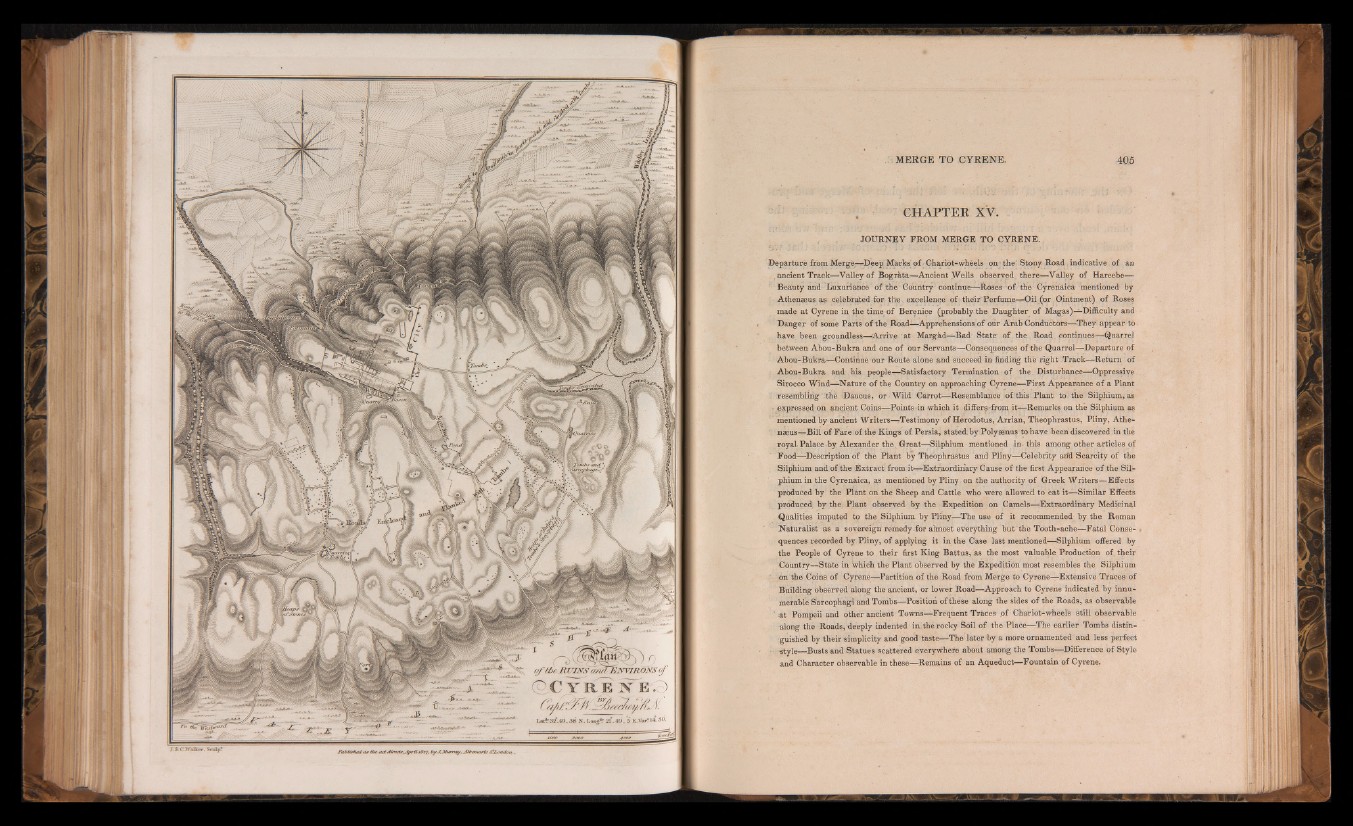
CHAPTER XV.
JOURNEY FROM MERGE TO QYRENE.
Departure from Mergèpr-Deep Marks of - Chariot-whéels on • the" Stony Road indicative of an
.ancient Track—Valley of Bogràta—Ancient Wells observed, there—Valley of Hareebe—
Beauty and Luxuriance of the'Country continue—Roses of the Cyrenaica mentioned by
Athenæus as celèbrated for th e . excellence of their'Perfume-r-Qil (or .Ointment) of Roses
made at Cyrene in the time of Berenice (probably the Daughter of Magas)—Difficulty and
Danger of some Parts of the Road—Apprehensions of our Arab Conductors—They appear to
have, been groundless—Arrive ‘at Margàd—Bad State- of the. Road continues—Quarrel
between Abou-Bukra and one of our Servants—Consequences of the Quarrel—Departure of
Abou-Bukra-—Continue our Route alóne and succeed in finding the right Track—Return of
Abo,u-;Bukra and his people-—Satisfactory Termination of the Disturbance—Oppressive
Sirocco Wind—Nature of the Country on approaching Cyrene—First Appearance of a Plant
I resémbling ' thè -Daucus, ór Wild Carrot—Rèsemblance of ! this Plant to; the Silphium, as
-expressed on ancient Coins—Points-in which it di ffers-from it—-Remarks on the Silphium as
: mentioned by ancient Writers—Testimony of Herodotus, Arrian, Theophrastus, Pliny, Athe-
i naeus—Bill of Fare ofithe Kings of Persia, stated, by Polyæ'nus to;have been discovered in the
royal-Palace-by. Alexander thes Great—Silphium mentioned -in- this among other articles pf
Food—Description of the Plant by Theophrastus and Pliny—CéÎebrity arid Scarcity of the
Silphium and.of the Extract, from it-—Extraordinary Cause of the first Appearance of the Silphium
in the Cyrenaica, as mentioned by Pliny.on the authority of Greek W riters—Effects
produced by the Plant oh the Sheep and Cattle who were allowed to eat it—Similar Effects
: produced by the Plant observed by the Expedition on Camels—Extraordinary Medicinal
Qualities imputed to the Silphium by Pliny—The use of it recommended by the Roman
Naturalist as a sovereign remedy-for almost everything but the Tooth-ache—Fatal Consequences
recorded by Pliny, of applying it in the Case last mentioned—Silphium offered by
the People of Cyrpne to their first King Battus, as the most valuable Productipn of. their
Country—State in which the Plant observed by thè Expedition most resembles the Silphium
on the Coins of Cyrene—Partition of the Road from Merge to Cyrene—Extensive Traces of
Building observed along the ancient, or lower Road—Approach to Cyréne indicated by innumerable
Sarcophagi and Tombs—Position of these along the sides of the Roads, as observable
at Pompeii and other ancient Towns—Frequent Trâces of Chariot-wheels still obsérvable
along the Roads, deeply indented in. the rocky Soil of the Place—The earlier Tombs distinguished
by their simplicity and good taste—The later by a more, ornamented and less perfect
-style—Busts and Statues scattered èverywhere about among the Tombs—Difference of Style
and Character observable in these—Remains of an Aqueduct—Fountain of Cyrene,